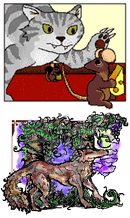 Fables are short stories which teach a lesson and are often about animals.
The supposed author of these Fables, Aesop, is thought to have lived from
620 to 560 B.C., but his place of birth is uncertain. Whether he came from
Ethiopia, Phrygia, Samos, Athens, Sardis or Thrace, we do not know, but
some early writers say that he was the slave of a citizen named Iadmon
at Samos, in what is now Greece.
Fables are short stories which teach a lesson and are often about animals.
The supposed author of these Fables, Aesop, is thought to have lived from
620 to 560 B.C., but his place of birth is uncertain. Whether he came from
Ethiopia, Phrygia, Samos, Athens, Sardis or Thrace, we do not know, but
some early writers say that he was the slave of a citizen named Iadmon
at Samos, in what is now Greece.
According to Herodotus, writing about 200 years later, Aesop met his end violently, being thrown over a precipice by the people of Delphi. Exactly how he was given offence is uncertain. One writer says it was due to the biting sarcasm in the Fables; another says that he embezzled money given him by King Croesus of Lydia; and yet another version has it that Aesop stole a silver cup.
Aesop had undoubtedly been freed by his master, Iadmon, for he later lived at the court of King Croesus, and it was here that he met the great Athenian statesman and scholar, Solon. A relative of Solon was Peisistratus, ruler of Athens, and Aesop visited his court, where he was able to persuade the citizens to allow their ruler to keep his throne. He did this by telling them the Fable of the Frogs Desiring a King, and such was Aesop's eloquence that Peisistratus was able to remain as dictator.
There are some writers who deny the existence of such a person as Aesop, and it is true that we have but scanty details of his life and work. Even his appearance is in dispute. According to a monk of Constantinople, named Maximus Planudes, writing in the 14th century, Aesop was an ugly, deformed dwarf, and the famous marble statue at the Villa Albani in Rome shows
him in this guise. But Plutarch, writing some 1,300 years earlier, says nothing about his appearance. Indeed, the Athenians are said to have put up a noble statue in honor of Aesop.
By the time of the Middle Ages, three collections of the so-called Aesop's Fables existed: one put together by the monk Maximus Planudes in the 14th century; another published in Heidelberg in 1610; and a manuscript discovered in Florence, dating back probably to the 13th century. The Greek collection made by Maximus Planudes was published in Milan 1480, together with a Latin translation by an Italian scholar named Ranuzio. Today, Aesop's Fables can be read in more than 250 languages. The work was first printed in English by William Caxton in 1484, from his own translation made from the French.
Aesop told his stories to many people and they were passed down from generation to generation by word of mouth and were not written down for over two hundred years. Animals in Aesop's fables are always treated in an abstract or impersonal manner and are never given names. However, depending on the translator, the stories are often humorous and entertaining.
Children read fables as a part of literature, but Aesop used the fable as a means of political and social criticism. His fables have meaning for us today, but to assure that the reader understands the message, a moral is added to the fable.
Websters' definition:
moral - (adj.) a. of or relating
to principles of right and wrong in behavior, b. expressing or teaching
a conception of right
behavior. (n.) the moral significance or practical lesson
(as of a story)
Their moral lessons are as true today as they were 2,500 years ago when Aesop was alive.
Animal Farm is a fable: animal
characters represent human personality types and emphasize human traits
in the extreme. The moral taught by the fable is clearly that all human
beings are not equal, and that the simplistic view that they are leads
inevitably to domination and exploitation of the naive by the cynical and
ruthless. Having chosen animals to represent human extremes, Orwell distances
the reader from the characters.
Copyright. All Rights Reserved - Creator: D. S. Truitt
The Rice School/La Escuela Rice - HISD and Rice University
http://outreach.rice.edu/~dstruitt/Lessons/Orwell/aesop.html